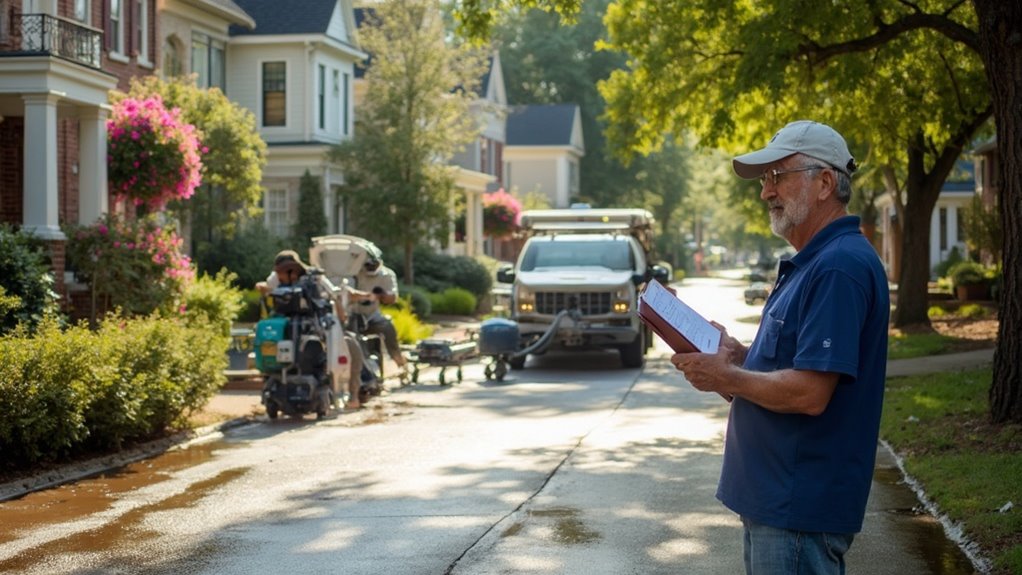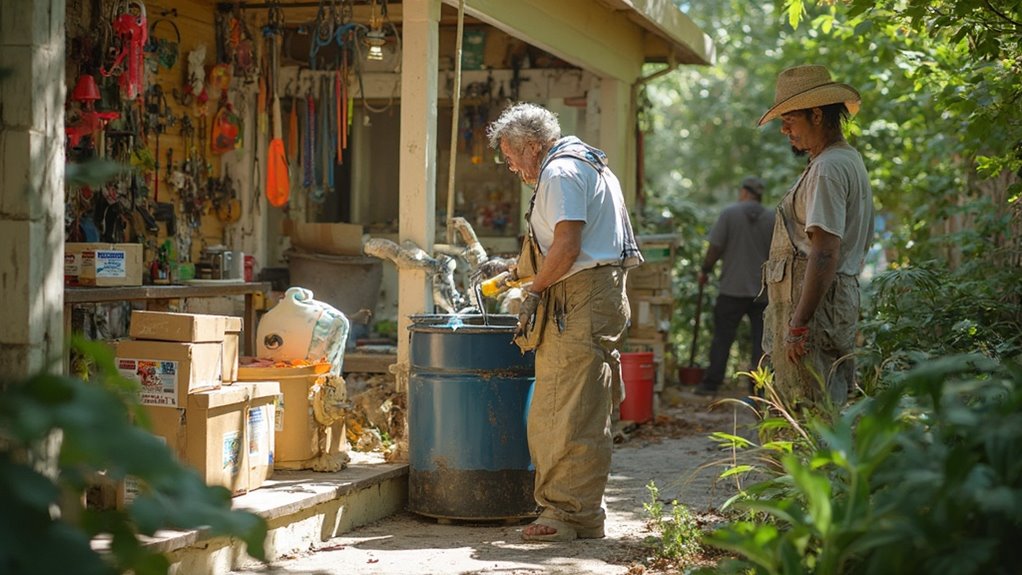For effective restoration preparedness in Smyrna, Georgia, it's crucial to act quickly when water damage occurs. Start by evaluating impacted areas for visible signs like discoloration or swelling. Use moisture detection tools for a thorough appraisal. When it's time for extraction, employ submersible pumps or wet/dry vacuums depending on the scale of the issue. After water removal, drying techniques like high-powered fans and dehumidifiers should be utilized to prevent further damage. Regular maintenance, such as inspecting plumbing and clearing gutters, can help avert future problems. Uncover key strategies to solidify your preparedness plan.
Key Takeaways
- Familiarize yourself with local emergency restoration services available 24/7 for quick response to water damage incidents in Smyrna.
- Regularly inspect your home for plumbing leaks and maintain gutters to prevent water damage during heavy rains.
- Invest in moisture detection tools to assess potential water damage areas and act swiftly to mitigate risks.
- Create an emergency plan that includes contact information for restoration specialists and local resources to expedite recovery.
- Maintain indoor humidity levels between 30% and 50% to reduce the risk of mold growth and water damage in your home.
Importance of Immediate Action

Immediate action is vital when facing disasters, as it greatly influences the extent of damage and recovery outcomes. By prioritizing emergency response, you can limit the initial damage and prevent secondary issues like mold growth and structural instability. Quick action reduces remediation costs, allowing you to recover financially while expediting the overall recovery process.
When you act swiftly, you minimize health hazards that can arise from prolonged exposure to water damage. This proactive approach not only protects your property but likewise safeguards the well-being of occupants and remediation workers. Delayed responses often lead to compounded damage, complicating the remediation process and increasing costs. Quick action can help in maintaining property value and safety, ensuring a more secure environment. Additionally, prompt water removal reduces property damage by up to 17%, highlighting the importance of immediate action.
Engaging specialists who provide 24/7 emergency services is essential. They bring expertise in damage mitigation, guaranteeing prompt assessments and effective strategies to curtail further damage. By coordinating with authorities and having access to vital equipment, these professionals streamline your recovery efforts.
To guarantee immediate action, keep contact information for reputable disaster remediation services readily available. Create and practice emergency communication plans, gather necessary supplies, and stay informed through community alert systems. These steps prepare you to respond effectively when disasters strike, protecting both your property and health.
Assessing Water Damage
After taking swift action in response to water damage, the next step is to thoroughly assess the situation. Begin with a visible inspection of affected areas—walls, ceilings, and floors. Look for signs like discoloration, swelling, and buckling surfaces. Don't overlook hidden spaces such as cabinets and closets, as these areas can harbor undetected damage.
Utilizing moisture detection tools is crucial. Moisture meters, both pin and pinless, help gauge levels in wood, drywall, and carpets. Infrared cameras reveal temperature differences that indicate moisture presence, allowing for detailed moisture mapping throughout your property. Understanding the categories of water damage is essential for effective assessment and remediation.
Here's a summary of what to look for during your assessment:
| Criteria | Visible Signs | Detection Tools |
|---|---|---|
| Walls & Ceilings | Staining, Warping | Moisture Meters |
| Floors | Buckling, Discoloration | Infrared Cameras |
| Hidden Areas | Mold Growth | Borescopes |
| Structural Integrity | Wood Rot, Cracks | Visual Inspection |
| Air Quality Issues | High Humidity | Hygrometers |
Water Extraction and Removal

Once water damage has been assessed, the next critical step is water extraction and removal, which must be executed promptly to minimize further deterioration. Effective water extraction techniques are vital in this emergency response phase. Begin with submersible pumps for large volumes of standing water, or utilize trash pumps for debris-laden fluid. For smaller areas, portable water extraction units can suffice, while truck-mounted equipment is ideal for extensive projects.
Wet/dry vacuums make excellent tools for DIY extraction, especially in confined spaces. These vacuums come in various sizes, so consider renting one if you don't own it. Remember to frequently empty the unit to maintain suction power. For minor spills, manual extraction methods—like mops, buckets, and sponges—are effective. Squeegees can help push water toward extraction points on hard surfaces, while siphoning can be useful for small water bodies.
For more complex situations, specialized equipment like injectidry systems can target hard-to-reach areas, and infrared cameras can detect hidden moisture pockets. By employing these strategies, you'll guarantee a thorough approach to water extraction and removal, setting the stage for successful restoration.
Drying and Dehumidification
Effective water extraction sets the stage for the next phase: drying and dehumidification. This critical step guarantees that any residual moisture is promptly addressed, preventing further damage. Mastering drying techniques and dehumidification methods is vital for successful restoration. Here are four key strategies to reflect on:
- Heat Drying Methods: Utilize direct, indirect, or infrared heaters to increase ambient temperatures, speeding up evaporation and reducing drying time considerably.
- Mechanical Air Movement: Deploy high-powered fans and specialized airflow products to improve circulation, guaranteeing moisture is removed from all areas effectively.
- Dehumidifiers: Implement dehumidifiers to extract water vapor from the air, especially in humid conditions. Pairing them with fans optimizes the drying process.
- Advanced Techniques: investigate suction drying and the push-pull method for layered structures, along with in-place drying strategies to manage wet items without removal.
Preventing Future Water Damage

To safeguard your home from future water damage, implementing proactive measures is vital. Start with preventive maintenance by inspecting your plumbing regularly for leaks, moisture, or corrosion. Replace old pipes and hoses on appliances like washing machines and dishwashers. Clean gutters and downspouts often to guarantee proper water drainage away from your foundation. Don't overlook your roof and attic; check for missing shingles and signs of leaks.
Controlling indoor humidity is another significant factor. Maintain levels between 30% and 50% using dehumidifiers, especially in high-moisture areas like bathrooms and kitchens. Proper ventilation is key—install exhaust fans where necessary and confirm good insulation to prevent condensation. Regularly check caulking around windows and doors to eliminate moisture entry points.
Consider installing protective devices to improve your defenses. Sump pumps with battery backups can manage excess basement water, while water leak detection devices alert you to issues before they escalate. Finally, focus on exterior water management. Clean your gutters, install French drains, and disconnect hoses during freezing weather to protect your home from potential damage. These measures collectively strengthen your home against water damage risks.
Conclusion
To sum up, taking swift action in Smyrna can be the lifeline your home needs to recover from water damage. By evaluating the situation, extracting water, and ensuring thorough drying, you're not just restoring your space; you're reinforcing its resilience against future threats. Like a phoenix rising from the ashes, your home can emerge stronger. Remember, prevention is key—so keep your defenses up to safeguard your sanctuary from the unpredictable storms of life.







